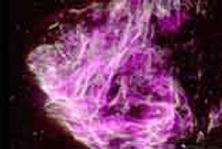Report from American Astronomical Society: Milky Way is Inching Toward a New Era (Photos)
Following is a report presented at the 200th meeting of the American Astronomical Society held in June 2002 in New Mexico, recent discovery in astronomy has disclosed the coming of cosmic drastic change. The frequent Gamma explosions, Supernova explosions and reorganization, starbursts all indicate that our universe has undergone drastic change. This new research results shows that our Milky Way is no exception. Ancient China deems that the cosmos and human society are one. Through the observation of cosmic change could predict the change in human society. The colossal change may forecast the drastic change in human society.


______________________________________________
Dramatic Increase in Supernova Explosions Looms
By Robert Roy Britt
Senior Science Writer
11 June 2002
ALBUQUERQUE, N.M. - The center of our Milky Way Galaxy is inching toward an era of intense fireworks when stars will be born 100 times more frequently than today and many will die quick, explosive deaths, according to new research.
A huge and dense ring of interstellar gas is collecting near the galactic center and approaching a density that will, in about 200 million years, generate a burst of star formation that could transform the very appearance of our galaxy as seen from afar.
Many of the stars will be massive and short-lived. They will forge heavy elements that cannot be created any other way. When they die, they will fling these elements out into the galaxy at up to 20 million mph (32 million kilometers per hour) to seed the development of other, longer-lived stars like our Sun.
"They'll quickly use up their fuel and explode as supernovae," said Antony Stark of the Harvard-Smithsonian Center for Astrophysics. "Right now, we see one supernova in our galaxy about every 100 years. When the starburst happens, we'll see one supernova every year."
The explosions will be too far away for most of them to be visible to the unaided eye from Earth, Stark told SPACE.com. "It would, however, be a whopping big signal to current scientific instrumentation."
Supernovae are among the most energetic events in the universe and can momentarily outshine an entire galaxy.
Critical density
Stark and his colleague, Chris Martin, used a telescope in Antarctica to map so-called submillimeter wavelength radiation -- between radio waves and infrared on the electromagnetic spectrum -- coming from carbon monoxide in a portion of the ring of gas. While others have made similar measurements, the new data involves very high frequencies that allowed for a better estimate of gas density in a region of space 400 light-years square and roughly 25,000 light-years away.
Martin presented the work here last week at the 200th meeting of the American Astronomical Society.
"We can combine our map with the recent X-ray map of the galactic center taken by NASA's Chandra X-ray Observatory, as well as with observations at other wavelengths of light," Martin said. "Together, the data allow us to build a complete picture of the environment near the center of our galaxy."
The gas ring contain the diffuse mass of millions of Suns. It is near a critical density, the new study shows, beyond which it will form one or two clouds that will collapse into the center of the galaxy, triggering the star formation. It won't be the first time; every 500 million years or so, enough material makes its way toward the galactic center -- drawn there by the tremendous gravity of a large concentration of stars and a central black hole -- to create a similar scenario.
Other researchers have observed similar starburst activity in other galaxies. Notably, a galaxy called M82 is a tremendous star factory, observations show.
"A large starburst could transform the Milky Way from its present state to a galaxy that looks more like M82," Stark said.
Reference: http://www.space.com/scienceastronomy/astronomy/boom_times_020610-1.html